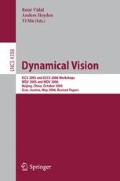Abstract
Articulated motions are partially dependent. Most of the existing segmentation methods, e.g. Costeira and Kanade[2], can not be applied to articulated motions.
We propose a novel algorithm for articulated motion segmentation called RANSAC with priors. It does not require prior knowledge of the number of articulated parts. It is both robust and efficient. Its robustness comes from its RANSAC nature. Its efficiency is due to the priors, which are derived from the spectral affinities between every pair of trajectories.
We test our algorithm with synthetic and real data. In some highly challenging case, where other motion segmentation algorithms may fail, our algorithm still achieves robust results.
Though our algorithm is inspired by articulated motions, it also applies to independent motions which can be regarded as a special case and treated uniformly.
Access this chapter
Tax calculation will be finalised at checkout
Purchases are for personal use only
Preview
Unable to display preview. Download preview PDF.
References
Fischler, M.A., Bolles, R.C.: Random Sample Consensus: A Paradigm for Model Fitting with Applications to Image Analysis and Automated Cartography. Comm. of the ACM 24, 381–395 (1981)
Costeira, J.P., Kanade, T.: A Multibody Factorization Method for Independently Moving Objects. IJCV 29(Issue 3), 159–179 (1998)
Ullman, S.: Maximizing rigidity: The incremental recovery of 3D structure from rigid and rubbery motion. Technical Report A.I. Memo No. 721, MIT (1983)
Sinclair, D.: Motion segmentation and local structure. In: Proceedings of the 4th International Conference on Computer Vision (1993)
Boult, T., Brown, L.: Factorization-based segmentation of motions. In: Proceedings of the IEEE Workshop on Visual Motion, IEEE Computer Society Press, Los Alamitos (1991)
Gear, C.W.: Feature grouping in moving objects. In: Proceedings of the Workshop on Motion of Non-Rigid and Articulated Objects, Austin, Texas (1994)
Ichimura, N.: Motion segmentation based on factorization method and discriminant criterion. In: Proc. IEEE Int. Conf. Computer Vision, pp. 600–605. IEEE, Los Alamitos (1999)
Kanatani, K.: Motion segmentation by subspace separation and model selection:model selection and reliability evaluation. Intl. J. of Image and Graphics 2(2), 179–197 (2002)
Zelnik-Manor, L., Irani, M.: Degeneracies, dependencies and their implications in multi-body and multi-sequence factorizations. In: Proc. IEEE Computer Vision and Pattern Recognition, IEEE Computer Society Press, Los Alamitos (2003)
Weiss, Y.: Segmentation using eigenvectors: A unifying view. In: International Conference on Computer Vision, Corfu, Greece, September 1999, pp. 975–982 (1999)
Ng, A., Jordan, M., Weiss, Y.: On spectral clustering: analysis and an algorithm. In: Advances in Neural Information Processing Systems 14, MIT Press, Cambridge (2002)
Tomasi, C., Kanade, T.: Shape and motion from image streams under orthography: a factorization method. IJCV 9(Issue 2), 137–154 (1992)
Vidal, R., Hartley, R.: Motion Segmentation with Missing Data using PowerFactorization and GPCA. In: IEEE Conference on Computer Vision and Pattern Recognition, IEEE Computer Society Press, Los Alamitos (2004)
Vidal, R., Ma, Y., Sastry, S.: ”Generalized Principal Component Analysis (GPCA). In: Proceedings of the IEEE Conference on Computer Vision and Pattern Recognition (CVPR’03), June 2003, IEEE Computer Society Press, Los Alamitos (2003)
Vidal, R., Ma, Y., Piazzi, J.: A New GPCA Algorithm for Clustering Subspaces by Fitting, Differentiating and Dividing Polynomials. In: Proceedings of the IEEE Conference on Computer Vision and Pattern Recognition (CVPR’04), June 27 - July 02, 2004, IEEE Computer Society Press, Los Alamitos (2004)
Yan, J., Pollefeys, M.: A Factorization-based Approach to Articulated Motion Recovery. In: IEEE Conf. on Computer Vision and Pattern Recognition, IEEE Computer Society Press, Los Alamitos (2005)
Tresadern, P., Reid, I.: Articulated Structure From Motion by Factorization. In: Proc. IEEE Conf. on Computer Vision and Pattern Recognition, IEEE Computer Society Press, Los Alamitos (2005)
Hartley, R., Zisserman, A.: Multiple View Geometry in Computer Vision. Cambridge University Press, Cambridge (2002)
Author information
Authors and Affiliations
Editor information
Rights and permissions
Copyright information
© 2007 Springer Berlin Heidelberg
About this paper
Cite this paper
Yan, J., Pollefeys, M. (2007). Articulated Motion Segmentation Using RANSAC with Priors. In: Vidal, R., Heyden, A., Ma, Y. (eds) Dynamical Vision. WDV WDV 2006 2005. Lecture Notes in Computer Science, vol 4358. Springer, Berlin, Heidelberg. https://doi.org/10.1007/978-3-540-70932-9_6
Download citation
DOI: https://doi.org/10.1007/978-3-540-70932-9_6
Publisher Name: Springer, Berlin, Heidelberg
Print ISBN: 978-3-540-70931-2
Online ISBN: 978-3-540-70932-9
eBook Packages: Computer ScienceComputer Science (R0)

